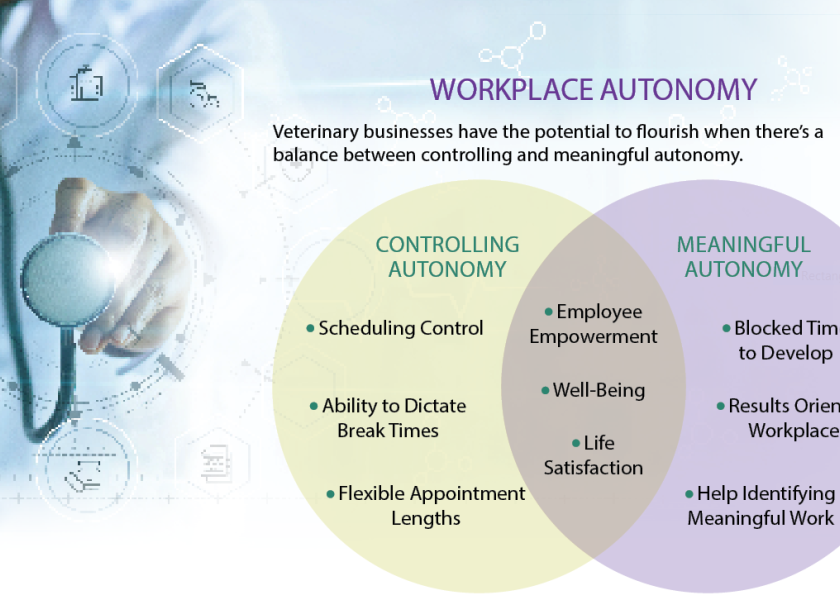Crafting Meaningful Work in the Veterinary Workplace

Eric Rooker, DVM, Dairy Doctors Veterinary Services and Operators to Owners, Plymouth, Wis. He can be reached at www.dairydoctors.com or at www.otovets.com
Struggling with feelings of burnout and stress at work are not unique to the veterinary profession. In fact, this is an endemic issue that pervades almost every level of our society. Scientists have begun to classify these internalized thoughts and feelings that are brought on at work as "Inner Work Life."
We've all experienced the power of Inner Work Life at some time. The waxing and waning of motivation throughout the day, that little voice that can ramp up your emotions building relationships or creating conflict – even altering how our subconscious mind perceives the actions of others around us during the day.
What Inner Work Life describes is our behind-the-scenes motivators – the silent judgments we make, the stories we craft that affect decisions made by us and how these interpretations control our own internal thoughts and actions.
Being able to actively control Inner Work Life stories means that an individual can be more autonomous in their days, that is to say, they feel as if they not their reactionary feelings are in control of the days. This means they are better able to pursue their own salient interests.
Researchers Deci and Ryan's field of Self Determination Theory has shown that autonomy is key to long-term life satisfaction and well-being. Autonomy forms a cornerstone for personal development and competency creation, as well as the building of meaningful relationships, all of which are necessary for improving job satisfaction and personal growth.
Autonomy at Work
So how can we increase autonomy? The first thing we must realize is there are differing types of autonomy. First, there is what I call "Controlling Autonomy," the ability to schedule your day in a way you desire to control it, letting the individual autonomy decide when tasks and appointments need to be done. This simple act of Controlling Autonomy can help us feel more efficient and better able to cope with daily challenges. Unfortunately, it does very little to progress personal growth and in the long-term only minorly improves feelings of autonomy.
This is a common and important level of autonomous control within our society given to employees by managers as a way to say they provide autonomy in the workplace. This makes Controlling Autonomy a common scapegoat by managers when they fail to provide a much more empowering type of autonomy, which I refer to as "Meaningful Autonomy."
Managers must focus upon Meaningful Autonomy, the ability to identify and make progress upon meaningful work, every day. When I first present this to managers many initially pooh-pooh it as impossible – that we cannot allow every employee to pursue their own interests, because the result would be a multidirectional company making no serious progress in any single area. But this overlooks the fact that Meaningful Autonomy needs not to take up an entire workday.
Instead, our workplaces have the potential to flourish when made up of balances between the two:
Controlling Autonomy – The scheduling of employer-derived work by the employee in the employee's desired way.
Meaningful Autonomy – The pursuit and progression of work intrinsically meaningful to the individual.
If work is structured this way, we could begin to harness Theresa Amabile's Progress Principle. Her research showed that progress in the arena of meaningful work led to a 76% chance the individual had a positive workday, experiencing a good overall mood, emotions and positive motivations. However, a noted lack of meaningful progress resulted in only a 13% chance of a positive workday.
Therefore, constructing a work environment where individuals are surrounded daily by the ability to schedule time for Meaningful Autonomy when they work on meaningful work will garner catalysts or tools they need to make progress on that work. They will be encouraged and nourished by management and peers to take action in that meaningful work every day as key to improving an employee's Inner Work Life Story, Life Satisfaction and Well-Being.
Fostering Meaningful Autonomy
It can be challenging to shift a workplace culture from a low autonomy environment to a highly autonomous environment. We saw this at the beginning of COVID when work-from-home employees first struggled with the sudden ability to control every aspect of their workday, which caused efficiency and productivity reductions.
Since then, things have improved as individuals began to explore this newfound freedom and develop their own efficiencies within the evolving work system. To aid our employees in this evolution toward increased autonomy, we may need to provide some structure and/or identify how they can discover, plan for, and pursue Meaningful Autonomy themselves.
Christine Robitchek's Personal Growth Initiative Lab has a great model for this: Personal Growth Initiative Scale (PGIS). It is a measure that allows us to track the individual’s readiness for Meaningful Autonomous growth, ability to plan for effective growth, opportunities and presence of relationships needed for growth, and the person’s tendency towards taking action in areas of Meaningful Autonomy.
Next up, in February: Part 2 of the "Crafting Meaningful Work Series" will focus on how managers and employees can seek to harness Robitchek's Personal Growth Initiative in today's veterinary workplace.







